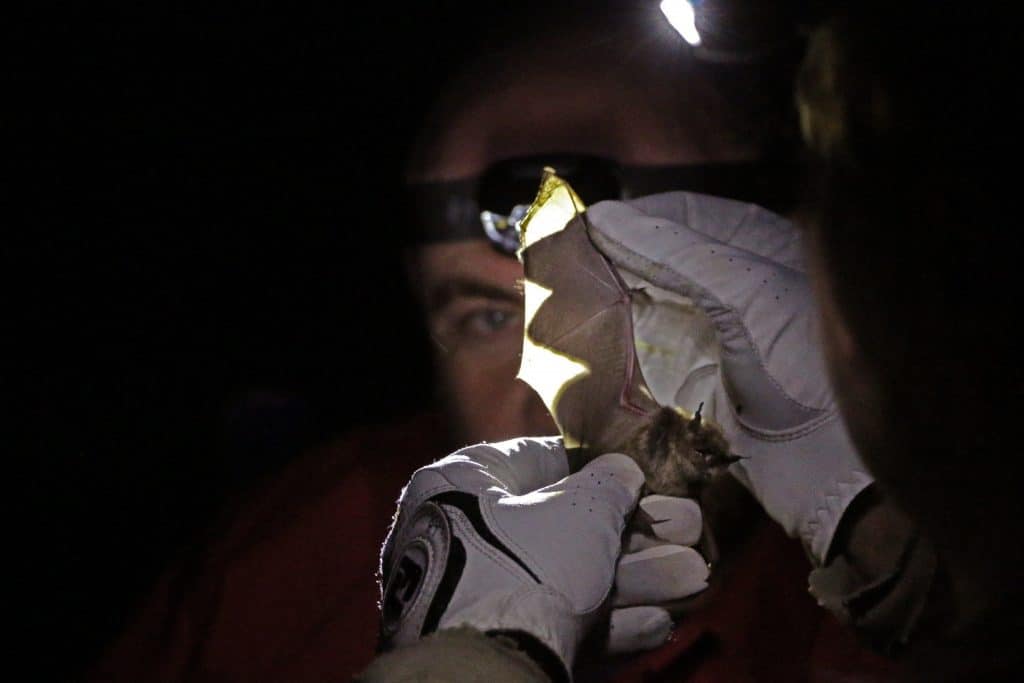The White-nose Syndrome Fungus is in Wyoming: What Now?
By
Brian Zinke, Communications Committee Chair/Newsletter Editor
Nichole Bjornlie, Communications Committee Member

WGFD Statewide Nongame Bird and Mammal Program Supervisor Zack Walker and Nongame Bat Biologist Laura Beard age a bat and check for wing spots, a symptom indicative of white-nose syndrome. Photo by Jessica Grant.
Since the discovery of white-nose syndrome (WNS) in the US in 2006, bat populations have been decimated across the eastern half of the country. Some species, such as the little brown bat (Myotis lucifugus), have seen declines as high as 90%. The disease is caused by a fungus called Pseudogymnoascus destructans, or Pd, for short. The fungus likes cold, damp conditions, such as those found in caves and mines where bats hibernate. The Wyoming Game and Fish Department (WGFD) has conducted winter hibernacula surveys for decades, but in recent years has started testing for the presence of Pd as the fungus and disease have continued to spread westward across the country. Biologists with the Wyoming Natural Diversity Database (WYNDD) have also started collecting samples to test for the presence of the Pd.
Recently, the fungus was detected for the first time in Wyoming.
This past spring, WYNDD biologists conducted surveys at the Fort Laramie National Historic Site in May 2018 to target the short timeframe between when bats emerge from hibernation, when they may still be carrying Pd, and later in the summer when they have cleaned all spores of the fungus from their skin. The biologists collected skin-swab samples from a little brown bat then sent them off to two different labs, which concluded the bat was positive for the fungus.
It is very important to understand that only the fungus that causes the disease has been found in Wyoming – no bats have tested positive for the disease so far.
However, now that the fungus is confirmed in Wyoming, what does that mean for wildlife, natural resource, and land managers?
Thankfully, the WGFD already requires all bat researchers in the state to follow national decontamination protocols for Pd and WNS as part of any research permits, a requirement that can help minimize the potential of the spread of the fungus from wildlife biologists. The WGFD has also convened a working group composed of state and federal biologists and land managers, as well as other interested parties, to provide updates and plan for surveillance and mitigation activities. The State will also be revisiting their WNS Strategic Plan, a revision that will involve substantial collaboration with all parties with an interest in managing bats and their habitat.
Resource managers are not the only ones who need to be aware of this development. Recreationists, especially spelunkers, are a critical piece to the management of the fungus and disease. Now that the fungus has been detected in Wyoming, respecting cave closures and ethical caving becomes increasingly important. Hibernation is a critical time for bats, as every arousal requires a substantial energetic cost, so identifying these important sites and mitigating disturbance, whether through cave closures or outreach activities, will be vital. Involving all groups and agencies in the process early on will be critical as we move forward with the impacts of Pd and WNS in the state.
For more information about Pd, white-nose syndrome, or how it might affect you, please use the resources and contacts below:
- National white-nose syndrome website: whitenosesynrome.org
- National Park Service white-nose subject pages, with videos, photos, maps: https://www.nps.gov/subjects/bats/white-nose-syndrom.htm
- Wyoming Game and Fish Department’s white-nose syndrome webpage: https://www.whitenosesyndrome.org/partner/wyoming-game-and-fish-department
- Map of white-nose syndrome occurrence by county: https://www.whitenosesyndrome.org/resources/map
- US Fish and Wildlife’s white-nose syndrome pages on Facebook (facebook.com/usfwswns) and Twitter (www.twitter.com/usfws_wns)
Wyoming Game and Fish Department
Renny MacKay
Renny.Mackay1@wyo.gov
University of Wyoming
Ian Abernethy
fisher@uwyo.edu
National Park Service
Patrick O’Driscoll
patrick_o’driscoll@nps.gov
Michelle Verant
michelle_verant@nps.gov
US Fish and Wildlife Service
Catherine Hibbard
catherine_hibbard@fws.gov


